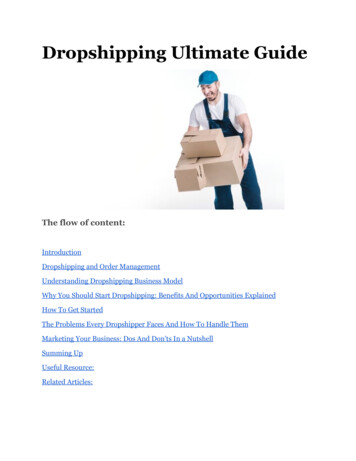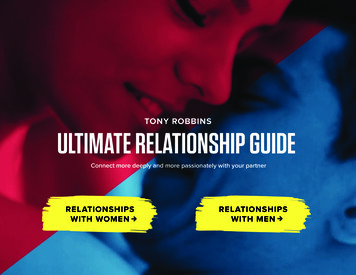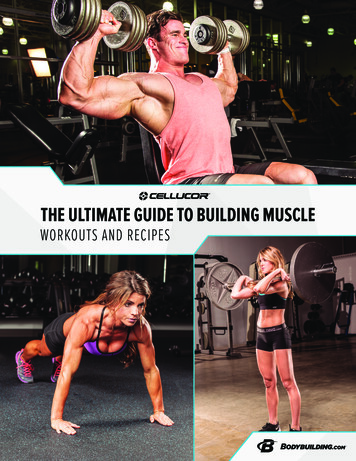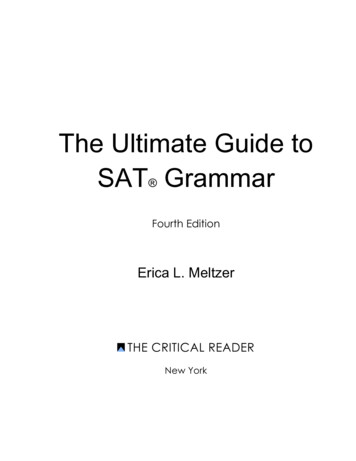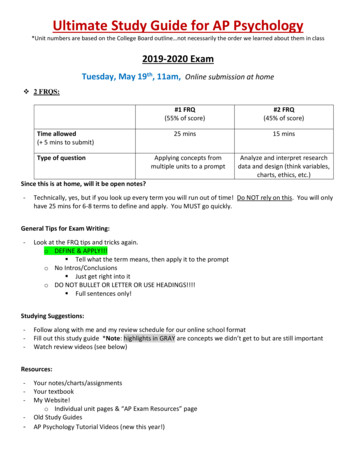
Transcription
Ultimate Study Guide for AP Psychology*Unit numbers are based on the College Board outline not necessarily the order we learned about them in class2019-2020 ExamTuesday, May 19th, 11am, Online submission at home 2 FRQS:Time allowed( 5 mins to submit)Type of question#1 FRQ(55% of score)#2 FRQ(45% of score)25 mins15 minsApplying concepts frommultiple units to a promptAnalyze and interpret researchdata and design (think variables,charts, ethics, etc.)Since this is at home, will it be open notes?-Technically, yes, but if you look up every term you will run out of time! Do NOT rely on this. You will onlyhave 25 mins for 6-8 terms to define and apply. You MUST go quickly.General Tips for Exam Writing:-Look at the FRQ tips and tricks again.o DEFINE & APPLY!!! Tell what the term means, then apply it to the prompto No Intros/Conclusions Just get right into ito DO NOT BULLET OR LETTER OR USE HEADINGS!!!! Full sentences only!Studying Suggestions:-Follow along with me and my review schedule for our online school formatFill out this study guide *Note: highlights in GRAY are concepts we didn’t get to but are still importantWatch review videos (see below)Resources:--Your notes/charts/assignmentsYour textbookMy Website!o Individual unit pages & “AP Exam Resources” pageOld Study GuidesAP Psychology Tutorial Videos (new this year!)
Unit 1 – SCIENTIFIC FOUNDATIONS OF PSYCHOLOGYIntro to Psychology 1.A- Recognize how philosophical and physiological perspectives shaped the development of psychological thought. Descartes and dualism Phrenology Darwin and evolution and how that shaped psychology, etc. 1.B- Identify the research contributions of major historical figures in psychologyNames to know: Rene Descartes Wilhelm Wundt Edward Titchener William James Max Wertheimer Sigmund Freud John B. Watson Ivan Pavlov B. F. Skinner Abraham Maslow Charles Darwin Charles Cecil Sumner Mary Whiton Calkins Dorothea Dix G. Stanley Hall Margaret Floy Washburn 1.C- Describe and compare different theoretical approaches in explaining behavior. Structuralism Functionalism Gestalt Behaviorism Psychoanalytic/Psychodynamic Humanistic Evolutionary approach Biological Approach Cognitive Approach Biopsychosocial Approach Sociocultural 1.D- Recognize the strengths and limitations of applying theories to explain behavior. Theories can’t explain all behaviors in all people 1.E- Distinguish the different domains of psychology. (TYPES of psychologists) *know the difference between a psychologist and a psychiatrist Biological Domain Cognitive Domain Clinical Domain Counseling Domain Developmental Domain Educational Domain Experimental Domain Industrial-Organizational (I/O) Domain
Personality DomainPsychometric DomainSocial DomainPositive DomainRESEARCH METHODS 1.F Differentiate types of research with regard to purpose, strengths, and weaknesses.Strengths/Weaknesses and Definitions of: Experiments correlational studies survey research tests case studies naturalistic observations lab observations longitudinal studies cross-sectional studies 1.G Discuss the value of reliance on operational definitions and measurement in behavioral research. Why are operational definitions important? 1.H Identify independent, dependent, confounding, and control variables in experimental designs. Independent variable Dependent Variable Confounding variableo Situation vs. participant-relevant confounding variables Experimental vs. Control groups 1.I Describe how research design drives the reasonable conclusions that can be drawn. Experiments are useful for determining cause and effect. The use of experimental controls reduces alternative explanationso The use of double blind and single blind methods Random assignment is needed to demonstrate cause and effect. Correlational research can indicate if there is a relationship or association between two variables but cannotdemonstrate cause and effect. *** Correlation does NOT equal causation!!!*** 1.J Distinguish between random assignment of participants to conditions in experiments and random selection ofparticipants, primarily in correlational studies and surveys. Sampling Population Representative sample (does your sample represent the larger group you’re studying?) Random SELECTION (selecting people to study/survey)Vs. Random ASSIGNMENT (in an experiment -everyone gets equal chance of being in control or experimental group) 1.K- Predict the validity of behavioral explanations based on the quality of research design. Confounding variables limit confidence in research conclusions.o Like .if your experimental basketball method is only tested on the tall, varsity team and not the shorterteam .can we really say the method worked? Participant Biaso Placebo effecto Hawthorne effect
Experimenter Biaso Pygmalion effect (Rosenthal study with “bloomer” students and teachers’ treatment of them) 1.L Apply Basic descriptive statistical concepts, including interpreting and constructing graphs and calculating simpledescriptive statistics. Measure of central tendency (where does the data “center”?)o Mean, median, mode Variation (how much does the data vary?)o Rangeo Standard deviation definition Z-score *see diagram Correlation coefficiento for correlations onlyo r -1 r 0 r 1o interpret a scatter plot graph Frequency distributiono Normal (bell curve) *see diagramo Bimodal (2 modes)o positive skew vs. negative skew (what the graphs look like - skier down the slope trick) *see diagram 1.M Distinguish the purpose of descriptive statistics and inferential statistics. Descriptive – describes the data (above measures like standard deviation) Inferential – infers what it meanso Statistically significant? (p 0.05 is significant) 1.N Identify how ethical issues inform and constrain research practices. Institutional Review Board (IRB)o They look over research proposals to make sure they are ethical 1.O Describe how ethical and legal guidelines protect research participants and promote sound ethical practice. Those provided by the American Psychological Association and Federal regulationso Coerciono Informed consento Anonymityo Confidentialityo Debriefingo Confederateo No (or minimal in rare circumstances) psychological or physical harm Institutional Animal Care and Use Committee (IACUC)o Rules around animal use in psych experiments These outline rules on how animals are obtained, cared for, if it is necessary to use them, bestmethods of euthanasia if necessary, etc.
Unit 2 – BIOLOGICAL BASES OF BEHAVIOR (BioPsych)Interaction of Heredity and Environment 2.A Discuss psychology's abiding interest in how heredity, environment, and evolution work together to shaperbehavior. 2.B Identify key research contributions of scientists in the area of heredity and environment. (Nature/Nurture) 2.C Predict how traits and behavior can be selected for their adaptive value. (evolutionary psych) Evolutionary Psych and Geneticso Darwin’s influence on psychologyo Key components of evolutionary psych Looking for universal traits Theorizing why they might be adaptive for our survivalo Minnesota Twin Study/ twin studies What they show us about nature vs. nurtureThe Endocrine System 2.D Discuss the effect of the endocrine system on behavior. Hormones!o Adrenal hormoneso Sex hormoneso melatoninOverview of the Nervous System and the Neuron 2.E Describe the nervous system and its subdivisions and functions. Central Nervous System (brain and spinal cord) peripheral nervous system somatic nervous system sensory system (w/ afferent neurons) motor system (w/ efferent neurons) autonomic nervous system sympathetic nervous system parasympathetic nervous system 2.F Identify basic processes and systems in the biological bases of behavior, including parts of the neuron. neuron (order of parts in neural transmission.be able to locate parts on neuron diagram) dendrite soma axon myelin sheath terminal buttons (or terminal branches) synapse afferent neurons/ efferent neurons/ interneuronsNeural Firing 2.G Identify basic process of transmission of a signal between neurons. resting potential action potential all-or-nothing rule mirror neurons
neurotransmitters excitatory/inhibitory (definition of) agonists/antagonists (definition of) functions of: Acetylcholine Norepinephrine Dopamine Serotonin GABA Glutamate EndorphinsInfluence of Drugs on Neural Firing 2.H Discuss the influence of drugs on neurotransmitters. Agonist Antagonist affect drugs have on neurotransmitterso (which drug category increases GABA? Blocks dopamine? Sharp increase then decrease in serotonin?)The Brain 2.I Describe the nervous system and its subdivisions and functions in the brain.know basic functions and locations hindbrain medulla pons cerebellum Reticular Formationforebrain limbic system thalamus hypothalamus amygdala hippocampuscerebral cortex hemispheres left hemisphere right hemisphere brain lateralization (or “localization of function”.what does each hemisphere do?)corpus callosumlobes (frontal, parietal, temporal, occipital)association areas (Broca’s area, Wernicke’s area) 2.J Identify the contributions of key researchers to the study of the brain Gazzaniga and Sperry
Tools for Examining Brain Structure and Function 2.K Recount historic and contemporary research strategies and technologies that support research. 2.L Identify the contributions of key researchers to the development of tools for examining the brain. accidents (Phineas Gage with the rod through his skull) lesioning TMS EEG CT scan MRI scan PET scan fMRIThe Adaptable Brain 2.M Discuss the role of neuroplasticity in traumatic brain injury. neuroplasticity definition Girl with half her braino Younger you are, more adaptable/plastic your brain is 2.N Identify the contributions of key researchers to the study of neuroplasticity. Gazzaniga, Ramachandran 2.O Describe various states of consciousness and their impact on behavior Levels of consciousness Conscious, preconscious, subconscious, nonconscious, unconscious Theories of hypnosis Social Role-Playing/ Social-Cognitive Theory Hypnosis as Dissociation 2.P Identify the major psychoactive drug categories and classify specific drugs, including their psychological andphysiological effects. Depressants Stimulants Hallucinogens 2.Q Discuss drug dependence, addiction, tolerance, and withdrawal. Difference between these 2.R Identify the contributions of major figures in consciousness research. Freud’s ideas of conscious levelsSleeping and Dreaming 2.S Discuss aspects of sleep and dreaming. Sleep stages (know the general cycle and when deep sleep or dreams occur)o NREM1o NREM2o NREM 3o REM Theories of Sleep/Dreaming (activation-synthesis) Major symptoms of sleep disorders: sleep apnea narcolepsy
Unit 3 – SENSATION AND PERCEPTIONPrinciples of Sensation 3.A Describe general principles of organizing and integrating sensation to promote stable awareness of the externalworld. Bottom-up processing Top-down processing Depth perceptiono Binocular depth cues Retinal disparity Retinal convergenceo Monocular depth cues Overlap Gradient/texture Relative size Linear perspective Aerial perspective Gestalt principleso Closure, proximity, figure-ground, continuity, similarity *see diagram 3.B Discuss basic principles of sensory transduction, including absolute threshold, difference threshold, signaldetection, and sensory adaptation. Difference threshold Absolute threshold Signal detection theory Sensory habituation Sensory adaptation 3.C Identify the research contributions of major historical figures in sensation and perception. Weber, Fechner, Wiesel, Hubel , Gibson and Walk (Visual Cliff study), Turnbull (Kenge and perception)Principles of Perception 3.D Discuss how experience and culture can influence perceptual processes. Perceptual set/ top-down processing/ our schemas (our expectations influence how we perceive things) Perceptual Constancies (shape, size, color)o Turnbull study with Kenge in Africa 3.E Discuss the role of attention in behavior. Cocktail party effect Divided vs. focused attention Change blindnessVisual Anatomy 3.F Describe the vision process, including the specific nature of energy transduction, relevant anatomical structures,and specialized pathways in the brain for each of the senses. What is light? why we see color how light waves travel through eye and get transduced major eye anatomy (including rods and cones – see diagrams ) feature detectors in occipital lobe in brain why we have a blind spot
trichromatic color theoryopponent-process color theoryafter images and why they occur 3.G Explain common sensory conditions. Color-blindness Synesthesia Conduction vs. nerve deafness Phantom limb syndrome CIPA (congenital insensitivity to pain) Sensory-conflict theory (motion sickness)Visual Perception 3.H Explain the role of top-down processing in producing vulnerability to illusion. Our expectations lead us to interpret things a certain way, even though it might not actually be the case(how illusions work)Auditory Sensation and Perception 3.I Describe the hearing process, including the specific nature of energy transduction, relevant anatomicalstructures, and specialized pathways in the brain for each of the senses. sound waves and how they’re measured how sound travels through the ear and is transduced major ear anatomy (see diagram) place vs. frequency theories of pitch hearing in the temporal lobe of brainChemical Senses 3.J Describe taste and smell processes, including the specific nature of energy transduction, relevant anatomicalstructures, and specialized pathways in the brain for each of the senses. how taste and smell are connected taste buds cilia olfactory bulb gustation tastants odorantsBody Senses 3.K Describe body sensory processes, including the specific nature of energy transduction, relevant anatomicalstructures, and specialized pathways in the brain for each of the senses. Afferent and efferent pathways visceral vs. somatic pain gate-control theory of pain kinesthetic sense vestibular sense sensory-conflict theory and how motion sickness works
UNIT 4 - LEARNINGIntroduction to Learning 4.A Identify the contributions of key researchers in the psychology of learning. Pavlov (dogs) Watson (Little Albert) Garcia (effect) Rescorla Thorndike (law of effect) Skinner (operant cond. – pigeons) Tolman (rats and cognitive maps) 4.B Interpret graphs that exhibit the results of learning experiments See diagrams 4.C Describe the essential characteristics of insight learning, latent learning, and social learning. Kohler – insight (chimpanzees and “aha” moments) Tolman – latent (rats learning maze but info “hidden” until needed) Bandura – social (Bobo doll learning from watching others) 4.D Apply learning principles to explain emotional learning, taste aversion, superstitious behavior, and learnedhelplessness. Watson – emotional learning (Little Albert classically conditioned fear) Garcia – taste aversion (classical cond. – to avoid foods after bad experience) Skinner – superstition (pigeon experiment – operant cond. – rewarded for random beh.s) Seligman – learned helplessness (dogs getting shocked not moving when they could) 4.E Provide examples of how biological constraints create learning predispositions. Instinctive drift – some things can’t be trained out of animals Phobias of dangerous things are common – meant to protect usClassical Conditioning 4.F Describe basic classical conditioning phenomena. Unconditioned stimulus Unconditioned response Neutral stimulus Conditioned stimulus Conditioned response Acquisition Extinction Spontaneous recovery Stimulus generalization vs. Stimulus discrimination Higher-order conditioning
4.G Distinguish general differences between principles of classical conditioning, operant conditioning, andobservational learning.o See diagramOperant Conditioning 4.H Predict the effects of operant conditioning. Positive Reinforcement Negative Reinforcement Positive Punishment Negative Punishment 4.I Predict how practice, schedules of reinforcement, other aspects of reinforcement, and motivation will influencequality of learning. primary vs. secondary reinforcer generalized secondary reinforcer shaping vs. chaining premack principle continuous vs. partial reinforcement Schedules of Reinforcement (see diagram)Social and Cognitive Factors in Learning 4.J Suggest how behavior modification, biofeedback, coping strategies, and self-control can be used to addressbehavioral problems. Behavior Modificationo token economyo Applied Behavior Analysis (ABA)
UNIT 5 – COGNITIVE PSYCHOLOGYIntroduction to Memory 5.A Compare and contrast various cognitive processes. Effortful vs. Automatic processing *Stroop effect Deep vs. shallow processingo Deep encoding meaning (semantic encoding)o Shallow encoding look or sound of something only (visual or acoustic encoding) Selective vs. divided attention Metacognition (thinking about your own thinking) 5.B Describe and differentiate psychological and physiological systems of memory. 3 processes of memoryo Encoding, storage, retrieval (more below)o Computer metaphor: Encoding typing document on computer Storage hitting “save” Retrieval opening the document later 3 box model of memoryo Sensory memory (echoic, iconic)o Short-term memory (STM)o Long-term memory (LTM) STM/Working Memory modelo Central executiveo Phonological loopo Visual-spatial sketchpad Know the hippocampus in brain helps convert STM to LTM 5.C Identify the contributions of key researchers in cognitive psychology. Noam Chomsky (language acquisition device) Ebbinghaus (the forgetting curve) Kohler (insight learning with chimps) Elizabeth Loftus (misinformation effect/ problems with eyewitness testimony) Bartlett (memory not a recording device – War of the Ghosts study) George A. Miller (STM “magic number” 7 /- 2 item limit)Encoding 5.D Outline the principles that underlie construction and encoding of memories. Encoding changing sensory info into something the brain can use/interpret (getting it into memory)Encoding can only happen if you pay attentionSome encoding takes work (effortful processing), some doesn’t (automatic processing)Visual encoding is usually superior to auditory encodingTips to encode things into memory are under section 5.GStoring 5.E Outline the principles that underlie effective storage of memories.o Storing retaining information in your memoryo Sensory memory – first stop for sensory information coming ino Shallow processing (iconic visual / echoic auditory)o Very short retention (1/2 to 2 seconds)o STM – a.k.a. working memory (what we use to currently process/think about something)o about a 30 second retentiono Info in STM needs to be encoded into LTM to be used latero George Miller (we can only hold 7 /- 2 objects in our STM at a time)
oLTMooohas an indefinite retention (most LTMs are there forever)LTMs can be retrieved back to STM to help us understand current situationsTypes of LTMs: Explicit memory (a.k.a. – declarative memory)- Episodic- Semantic (facts) Implicit memory (a.ka. – non-declarative memory)- Procedural memories- Information that has been primed Prospective memory Flashbulb memory Eidetic/photographic memory – VERY rareRetrieving 5.F Describe strategies for retrieving memories. Retrieving getting memories OUT of storage to use themRecall vs. recognitionCue-dependent memoryState-dependent memoryMood-congruent memoryForgetting and Memory Distortion 5.G Describe strategies for memory improvement and typical memory errors. Ways to remember:o Chunkingo Mnemonicso Maintenance rehearsalo Elaborative rehearsalo Distributed practice Ebbinghaus’ forgetting curve Tip of the tongue phenomenono Connected to semantic network theory (see diagram ) Serial position effecto Combo of primacy and recency effect Proactive vs. retroactive interference Anterograde vs. retrograde amnesia Reconstructed memorieso Bartlett – War of the Ghosts studyo Loftus - Misinformation effectBiological Bases for Memory 5.H Describe and differentiate psychological and physiological systems of short- and long-term memory. Hippocampus – STM to LTM declarative memorieso Case study of H.M. Cerebellum - procedural memories Long-term potentiation – neuron connections strengthened with useIntroduction to Thinking and Problem Solving 5.I Identify problem-solving strategies as well as factors that influence their effectiveness. General thinking terms:o Concept vs. prototypeo mental maps (Tolman)
Problem solving strategies (and effectiveness):o Trial and error (not very efficient)o Algorithm (ensures a solution but may take a long time)o Insight (aha! Moments Kohler’s chimps)o Deductive reasoningo Inductive reasoningo Dialectical reasoningo Heuristics (quick but not always accurate) availability heuristic representativeness heuristic *many others 5.J List the characteristics of creative thought and creative thinkers. Divergent thinking (as opposed to convergent thinking) Sternberg’s 5 components of creativity1. Expertise2. Imaginative thinking skills3. Venturesome personality4. Intrinsic motivation5. Creative environmentBiases and Errors in Thinking 5.K Identify problem-solving strategies as well as factors that create bias and errors in thinking. Mental set – (type of convergent thinking) - can get us stuck in a way of thinkingo Functional fixedness Confirmation bias Belief bias/belief perseverance Framing effectIntroduction to Intelligence 5.L Define intelligence and list characteristics of how psychologists measure intelligence. Intelligence – the ability to learn from one’s experiences, acquire knowledge, and use resources effectivelyin adapting to new situations or problem solving. Crystalized vs. Fluid intelligence Flynn Effect IQ formula 5.M Discuss how culture influences the definition of intelligence. Different cultures define intelligence in different ways *Stereotype threat – if you fear a stereotype might be made against you on a test, you may subconsciouslyperform worse because of the stress and prove it “true” 5.N Compare and contrast historic and contemporary theories of intelligence. Spearman- g factor Gardner - multiple Sternberg - triarchic Goleman - emotional 5.O Identify the contributions of key researchers in intelligence research and testing. Above theorists AND . Binet – French IQ tests Terman – U.S. IQ tests (*racist motivations) Galton – factor analysis, using stats to come up with standardized scores
Psychometric Principles and Intelligence Testing 5.P Explain how psychologists design tests, including standardization strategies and other techniques to establishreliability and validity. Reliable – can it be repeated and get similar results? Valid – does it actually measure what you aim to test?o Face validityo Construct validityo Criterion-related validity Concurrent validity Predictive validity Standardization Achievement test (see diagram ) Aptitude test 5.Q Interpret the meaning of scores in terms of the normal curve. Normal distribution (see Unit 1 and diagram ) 5.R Describe relevant labels related to intelligence testing. Gifted Savant Intellectual/cognitive disability 5.T Debate the appropriate testing practices, particularly in relation to culture-fair test uses. Maybe best culturally-fair tests don’t have words or stories at all just puzzlesComponents of Language and Language Acquisition 5.S Synthesize how biological, cognitive, and cultural factors converge to facilitate acquisition, development, anduse of language. Building blocks of language:o phonemeso morphemeso syntaxo semanticso pragmatics Stages of language development:1. cooing2. babbling3. one-word (holographic speech)4. two-word (telegraphic speech)5. full sentences Language acquisition theorists:o Chomsky LAD, overgeneralizationo Fernald Parenteseo Skinner Conditioning Critical period of language acquisition? (Genie case) Linguistic relativity hypothesis (Whorf)
UNIT 6 – DEVELOPMENTAL PSYCHOLOGYThe lifespan and Physical Development in Childhood 6.A Explain the process of conception and gestation, including factors that influence successful pre-nataldevelopment. Phases of fetal developmento Fertilization, germinal, embryonic, fetalo Teratogens 6.B Discuss the interaction of nature and nurture (including cultural variations). Specifically, physical development, inthe determination of behavior. Nature/nurture debate 6.C Discuss maturation of motor skills. Cephalocaudal (head to toe growth) Proximodistal (center of body and outward growth)o Gross motor skills develop before fine motor skillsSocial Development in Childhood 6.D Describe the influence of temperament and other social factors on attachment and appropriate socialization. Thomas and Chess (temperament)o Easy, difficult, slow to warm-up Harlowo monkey experiment detailso contact comfort Ainsworth (&Bowlby)o attachment styleso strange situation secure insecure-avoidant insecure-ambivalento effects of attachment types later in life 6.E Identify the contributions of major researchers in developmental psychology in the area of social development inchildhood. Bandura (observational learning) Baumrind (parenting styles) Lorenz (imprinting) Harlow (contact comfort) Ainsworth (attachment) Freud (personality) Erikson (social development 8 stages) 6.F Discuss the interaction of nature and nurture (including cultural variation), specifically social development, in thedetermination of behavior. 6.G Explain how parenting styles influence development. Diana Baumrindo Authoritariano Permissive – Indulgent/Neglectfulo Authoritative importance of matching parenting style to temperament to form healthy attachments
Cognitive Development in Childhood 6.H Explain the Maturation of cognitive abilities (Piaget's stages, Information process). Piageto assimilationo accommodationo how both of these work with schemaso Stages:o Sensorimotoro infant reflexeso object permanenceo Preoperationalo egocentrico Should develop. theory of mind conservationo Concrete Operationso can conserve, reverseo rule boundo Formal Operationso abstract thinkingo Vygotskyo ZPDo scaffolding 6.I Identify the contributions of major researchers in the area of cognitive development in childhood. Piaget and VygotskyAdolescent Development 6.J Discuss maturational challenges in adolescence, including related family conflicts. Teen identity developmento James Marcia Identity achievement Identity foreclosure Identity diffusion Identity moratorium Why family conflicts happen often at this age (see readings online) Puberty (primary vs. secondary sex characteristics)Adulthood and Aging 6.K Characterize the development of decisions related to intimacy as people mature. Erikson’s stages and ages (see chart next page) 6.L Predict the physical and cognitive changes that emerge through the lifespan, including steps that can be takento maximize function. More feelings of control lead to better health outcomes in seniors (study summary - ”Effects of Choice ”) Keeping mind active with mental puzzles helps stay sharp 6.M Identify the contributions of key researchers in the area of adulthood and aging Erik EriksonMoral Development 6.N Identify the contributions of major researchers in the area of moral development. Kohlberg and Gilligan
6.O Compare and contrast models of moral development. Kohlbergo Heinz Dilemma basics.what he looked for in answers Preconventional Conventional Postconventional Gilligan’s criticisms (K. only focused on males)Gender and Sexual Orientation 6.P Describe how sex and gender influence socialization and other aspects of development. Where gender roles and/or stereotypes develop Research on influences on sexual orientation What the Kinsey study was
UNIT 7 – MOTIVATION, EMOTION, AND PERSONALITYTheories of Motivation 7.A Identify and apply basic motivational concepts to understand the behavior of humans and other animals. Instincts Incentives Needs vs Driveso Primary vs. secondary Intrinsic vs. extrinsic motivation Overjustification effect Self-efficacy Achievement motivation 7.B Compare and contrast motivational theories, including the strengths and weaknesses of each Evolutionary theory of motivation Drive reduction theoryo Homeostasis (see diagram above) (Optimum) Arousal theory (including the Yerkes-Dodson law) (see diagram ) McClelland’s theoryo Needs for: affiliation, power, achievement Maslow's hierarchy of needs theory Cognitive dissonance theory (in social psych) – we are driven to align our thoughts and behaviors. We feeluncomfortable when our beliefs about ourselves and actions don’t line up, then we change our thoughts oractions to make them match. 7.C Describe research findings in specific motivations. Hungero Hypothalamus – (hunger center) Lateral hypothalamus – makes you feel hungry Ventromedial hypothalamus – controls feeling fullo Eating disorders (bulimia, anorexia) Sexo Sexual response cycle (excitement, plateau, orgasm, resolution)o Kinsey study Socialo Affiliationo Ostracism 7.D Identify contributions of key researchers in the psychological field of motivation and emotion. Darwin Ekman – universal expressions, micro-expressions Schacter-Singer, James and Lange, Cannon-Bard McClelland MaslowSpecific Topic in Motivation 7.E Discuss the biological underpinnings of motivation, including needs, drives, and homeostasis. See 7.ATheories of Emotion 7.F Compare and contrast major theories of emotion Evolutionary theories (primary emotions) Paul Ekman's research on cross-cultur
Unit 2 – BIOLOGICAL BASES OF BEHAVIOR (BioPsych) Interaction of Heredity and Environment 2.A Discuss psychology's abiding interest in how heredity, environment, and evolution work together to shaper behavior. 2.B Identify key research contributions of scientists in the area of heredity and environment. (




